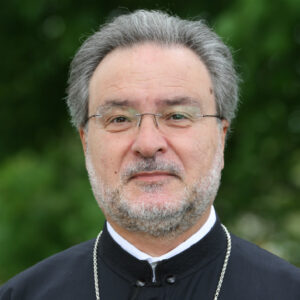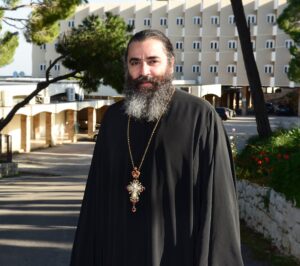This is an important statement on ecological metanoia by His Eminence Met. Serafim. The English text is coming soon:
Οικολογική μετάνοια από τις οικολογικές μας αμαρτίες
Του Σεβ. Μητροπ. Ζιμπάμπουε Σεραφείμ
Στη σημερινή Ευαγγελική Περικοπή (Ματθαίου 4, 18 – 23) βλέπουμε πως τέσσερις από τους σημαντικότερους Μαθητές του Χριστού, στην κλήση τους να τον ακολουθήσουν, εγκαταλείπουν τα πάντα χωρίς δισταγμό κι αμφιβολία. Θυσιάζουν τα πάντα για να γίνουν Μαθητές του Χριστού.
Μέσα στη παγκόσμια κρίση που ζούμε με Πανδημίες και οικολογικές καταστροφές του Πλανήτη μας, ίσως πρέπει να προσθέσουμε στην σημερινή ευαγγελική περικοπή και το χωρίο Ματθαίου 4,17 που πολύ σοφά ο Απόστολος Ματθαίος το έχει ως εισαγωγή στην σημερινή ευαγγελική περικοπή, που φαίνεται πριν πολλά χρόνια, αυτοί που καθιέρωσαν το Τυπικό των περικοπών το απέκοψαν. Το χωρίο αυτό είναι πολύ σημαντικό για πολλούς λόγους, πρώτον, τονίζεται ότι αρχίζει η έναρξη του δημόσιου κηρύγματος του ο Ιησούς και δεύτερο, το πρώτο πράγμα που τονίζεται είναι η «Μετάνοια» και η Βασιλεία των Ουρανών («από τότε ήρξατο ο Ιησούς κηρύσσειν και λέγειν, μετανοείτε ήγγικε γαρ η Βασιλεία των ουρανών»). Το κήρυγμα της Μετανοίας, ως νέος τρόπος ζωής και νέος τρόπος σκέψεως, είναι και το πρώτο πράγμα που τόνιζε κι ο άγιος Ιωάννης ο Πρόδρομος, που με τη Πρόνοια του Θεού προετοίμασε την οδό του Ιησού Χριστού. Το κήρυγμα της Μετανοίας το τονίζει κι ο Απόστολος Πέτρος την Ημέρα της Πεντηκοστής, που θεωρείται η Γενέθλιος Ημέρα της Εκκλησίας («μετανοήσατε» Πράξεις 2,38). Η ζωή της πρώτης χριστιανικής κοινότητας που άρχισε να ζει εν μετανοία αποτελεί το ζωντανό παράδειγμα και για την σύγχρονη κοινωνία για να προστατευθούν τα θύματα των προβλημάτων της κλιματικής αλλαγής από τις οικολογικές μας αμαρτίες («κανείς δεν έλεγε ότι κάτι από τα υπάρχοντα του είναι δικό του, αλλά ήσαν εις αυτούς κοινά…. και δεν υπήρχε κανένας φτωχός μεταξύ τους» Πράξεις Αποστόλων 4,32 – 34). Το κήρυγμα της Μετανοίας τονίζεται ξανά την ημέρα της Αναλήψεως του Ιησού εις τους ουρανούς («κηρυχθήναι επί τω ονόματι Αυτού μετάνοιαν» Λουκά 24,47). Η επιστημονική Κοινότητα του Ο.Η.Ε. για τα προβλήματα της Κλιματικής Αλλαγής τονίζει τον ανθρώπινο παράγοντα ως τον κύριο υπεύθυνο για την μόλυνση της ατμόσφαιρας και τις οικολογικές καταστροφές που απειλούν την επιβίωση της Ανθρωπότητας και τη καταστροφή του Πλανήτη μας. Ο μόνος τρόπος να αλλάξουν τα πράγματα για να προστατευθεί η Ανθρωπότητα και η ελπίδα για το μέλλον του Πλανήτη μας είναι να μετανοήσουμε από τις οικολογικές μας αμαρτίες και να αρχίσουμε να ζούμε ένα νέο τρόπο ζωής με ένα νέο τρόπο σκέψεως, όπως τους Αποστόλους του Ιησού Χριστού. Να προστατεύουμε τους συνανθρώπους μας και την όλη Δημιουργία του Θεού ως δώρο για όλες τις γενεές. Ο άγιος Ιωάννης ο Πρόδρομος μας καλεί «να ποιήσουμε καρπό άξιο της μετανοίας», (Ματθαίου 3,8) ,με την καλοδιάθετη απόφαση μας να μοιραζόμαστε αυτά που έχουμε με αυτούς που δεν έχουν τίποτα («εκείνος που έχει δύο χιτώνες να δώσει εις εκείνο που δεν έχει και εκείνος που έχει τρόφιμα να κάνει το ίδιο» (Λουκά 2,11).
Στο βιβλίο της Γένεσης που περιγράφεται η Δημιουργία του κόσμου και ο κατακλυσμός του Νώε, τονίζεται με σαφήνεια ότι τα αίτια της καταστροφής του Πλανήτη μας προέρχονται από τη διαφθορά των ανθρώπων, δηλαδή από τις κάθε είδους αδικίες που διαπράττουμε προς τους συνανθρώπους μας (Γένεση 6,10-13).
Η Εκκλησία μας για να συνεχίσει σήμερα το έργον της με επιτυχία χρειάζεται ανθρώπους με τις ίδιες αρετές και με την ίδια αυτοθυσία όπως τους Αποστόλους μας. Αυτό όμως είναι μόνο η μία διάσταση της επιτυχίας της Εκκλησίας μας στο σωτηριολογικό της έργον. Η δεύτερη πραγματικότητα που πρέπει να χαρακτηρίζει τη ζωή της Εκκλησίας μας είναι η διάσταση της οικουμενικότητας και παγκοσμιότητας του χαρακτήρα του Ευαγγελικού της έργου, όπως σήμερα βλέπουμε να αναπτύσσεται η Ιεραποστολική μας διακονία εις τα πέρατα της Οικουμένης.
Η δεύτερη λοιπόν διάσταση του σωτηριολογικού έργου της Εκκλησίας μας είναι η συνεχής προσπάθεια της να μεταφέρει το Ευαγγελικό μήνυμα της Μετανοίας και σωτηρίας προς όλους τους ανθρώπους, προς όλες τις Εθνότητες, σε μαύρους και λευκούς, σε μικρούς και μεγάλους, σε όλες τις φυλές της γης και να βοηθούμε και να προστατεύουμε τα ορφανά και τις χήρες, τους καταδιωγμένους και τους αδικημένους, τους φτωχούς, τους ασθενείς, τους πρόσφυγες και τους μετανάστες, τους ασθενείς και τους ηλικιωμένους, τους ανάπηρους κι όλα εκείνα τα αθώα παιδάκια που πάσχουν από το φάσμα του αυτισμού ή άλλα συμπτώματα που δεν φέρουν καμία ευθύνη.
Ο βίος μας είναι κοινός και μπορούμε να κάνουμε τη ζωή μας όμορφη αν αφήσουμε χώρο στην καρδιά μας να βασιλέψει η Μεγάλη μορφή του Χριστού με την άδολη αγάπη μας και τη φιλανθρωπία μας και τη καλοσύνη μας προς κάθε κατεύθυνση. Μόνον αν αφήσουμε στη ζωή μας να μας καθοδηγεί ο Χριστός έχουμε ελπίδες για να ζήσουμε σε ένα καλύτερο κόσμο που θα μας οδηγήσει και στην αιωνιότητα του Παραδείσου.
Στην έναρξη λοιπόν του δημόσιου κηρύγματος του Ιησού και στη κλήση των πρώτων του Μαθητών και Αποστόλων, τονίζεται η Μετάνοια και η Βασιλεία των Ουρανών, με ζωντανό παράδειγμα και της δικής μας καθημερινής ζωής, τη διακονία των αγίων Αποστόλων.
Γι’ αυτό στη σημερινή αποστολική περικοπή (Ρωμαίους 2, 10 – 16) , ο Απόστολος Παύλος τονίζει ότι «είναι δόξα και τιμή για τον κάθε άνθρωπο που κάνει το καλό» . Όσοι δεν ζουν εν μετανοία, όπως συνέβη με το Ζακχαίο που έδειξε την μετάνοια του με την αλλαγή της ζωής του, με την αποκατάσταση της κοινωνικής δικαιοσύνης για τις κοινωνικές του αδικίες, μοιράζοντας τα υπάρχοντα του με αυτούς που αδίκησε Λουκά 19, 1- 10).
Ο Απόστολος Παύλος μας λέει στην σημερινή Αποστολική περικοπή, ότι όλοι οι άνθρωποι του Πλανήτη μας , θα κριθούν αν είναι άξιοι για τη Βασιλεία των ουρανών με τρία κριτήρια . Οι Εβραίοι αν είναι υπάκουοι στον Μωσαϊκό Νόμο, οι Χριστιανοί, στις εντολές του Χριστού, αν προστατεύουμε τους πάσχοντες και τους αδικημένους και την όλη Δημιουργία του Θεού, ιδιαίτερα το Πλανήτη μας, από οικολογικές καταστροφές, κι όλοι οι άλλοι με κριτήριο τη συνείδηση τους, με την έννοια ότι μπορούν να κρίνουν το καλό από το κακό και το άδικο από το δίκαιο.
Τελικά, η οικολογική μας μετάνοια από τις οικολογικές μας αμαρτίες, ως ένας νέος τρόπος ζωής, να ζούμε χωρίς να μολύνουμε το Πλανήτη μας και να αδικούμε τον συνάνθρωπο μας με τις κοινωνικές μας αδικίες , είναι μονόδρομος για τη προστασία της Ανθρωπότητας και την επιβίωση του Πλανήτη μας , ως δώρο Θεού για όλες τις γενεές, και μάλιστα γι’ αυτές που ακόμη δεν έχουν γεννηθεί, που αν συνεχίζουμε να ζούμε με τον τρόπο που ζούμε, πάμε να τους κληρονομήσουμε μια ζωντανή κόλαση και στη Γη.







